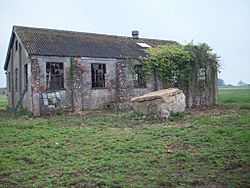Stow Maries Aerodrome facts for kids
Quick facts for kids Stow Maries Aerodrome |
|||||||
|---|---|---|---|---|---|---|---|
| Stow Maries, Essex in England | |||||||

Abandoned building at Stow Maries
|
|||||||
|
Location within Essex
|
|||||||
| Coordinates | 51°40′14″N 0°37′56″E / 51.670443°N 0.632104°E | ||||||
| Grid reference | TL820001 | ||||||
| Type | Home Defence (HD) airfield | ||||||
| Area | 118 acres (48 ha) | ||||||
| Site information | |||||||
| Operator | Royal Flying Corps Royal Air Force |
||||||
| Open to the public |
Yes | ||||||
| Site history | |||||||
| Built | August 1916 | ||||||
| In use | May 1917–April 1919 | ||||||
| Garrison information | |||||||
| Past commanders |
Claude Alward Ridley | ||||||
| Airfield information | |||||||
|
|||||||
Stow Maries Aerodrome is a very old airfield in Stow Maries, Essex, England. It was used by the Royal Flying Corps and later the Royal Air Force during the First World War. This airfield is special because it has many of its original buildings from that time. It is now a museum and visitor attraction where people can learn about its history.
Contents
Why Was Stow Maries Aerodrome Built?
The land for the airfield was first looked at in August 1916. It was ready for planes by May 1917. This airfield was built to help protect London from German air attacks. During the First World War, German airships called Zeppelins and large planes called Gotha bombers would bomb British cities.
Protecting Britain from Air Raids
Stow Maries was part of a bigger plan to set up airfields all across Britain. These airfields stretched from Dover in the south to Edinburgh in the north. Each base was placed about 10 to 30 miles apart. This network helped stop enemy aircraft from flying far inland.
Life at the Airfield During World War I
In April 1918, the airfield became part of the new Royal Air Force (RAF). A survey in October 1918 showed that 219 people worked there. There were also 16 Sopwith Camel planes. These planes belonged to No. 37 Squadron (Home Defence).
Buildings and Personnel
Some buildings were still being finished when the war ended in November 1918. Even so, some were completed in December 1918. The living areas could hold 204 men and 15 women. By the time the base closed in 1919, over 500 people and 36 aircraft were based there.
At first, planes were kept in two temporary hangars called Bessonneau Hangars. These were replaced with two stronger, permanent buildings in 1917.
Remembering Lieutenant Milburn
There is a gap in the hedge around the airfield known as Milburn's Gap. In April 1918, a pilot named Lieutenant Cyril Milburn crashed his Sopwith Camel plane there. His plane stalled (stopped flying) during take-off, and he sadly died.
Planes from that time were not always reliable. Out of ten pilots who died while flying from Stow Maries, eight died in accidents. Only two were shot down by the Royal Navy. Lieutenant Milburn is buried in the local churchyard under his real name, Edward Gerald Mucklow.
Stow Maries After the First World War
The airfield was not used again during the Second World War. However, it was looked at twice during that time. It was even bombed by enemy planes because it still looked like an airfield. In 1940, a Hawker Hurricane plane from 242 Squadron landed there after being damaged in a battle.
Preserving History
After the wars, the buildings and fields were used for farming again. In 1997, a group called the Royal Commission for Historical Monuments in England (RCHME) studied the site. They found signs of 47 original buildings. At least 24 of these buildings are still standing today. They are considered very important and have a special protection status.
In 2009, a group of people who love history started working to bring the airfield back to life. They wanted to use it for light aircraft and create a museum. This was because Stow Maries was the most complete First World War airfield left in England. In 2017, the Duke of Gloucester officially opened the second museum building at the site.
Notable People Connected to Stow Maries
- Claude Alward Ridley – He was a pilot who led No. 37 Squadron when they were based at Stow Maries.
Images for kids



